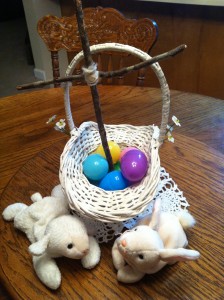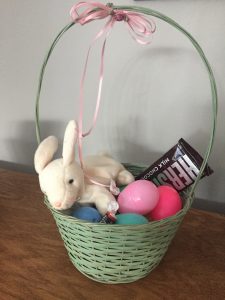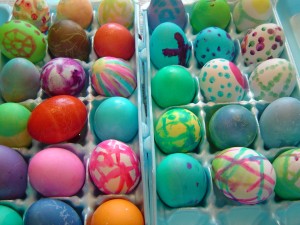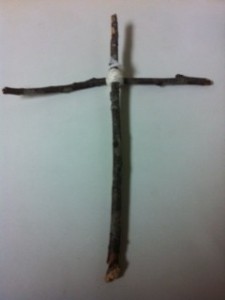
Easter, the celebration of the resurrection of Jesus, is our most important Christian holiday. Because it comes at springtime, some of our traditions at Easter are actually a part of the pagan springtime celebration. The name Easter is from Eostre, an Anglo Saxon goddess of Spring. The resurrection of Jesus coincided with the springtime celebration for this goddess. Through the years Christians began to incorporate the pagan springtime traditions with their celebration of the Resurrection.
But that was ok, according to Pope Gregory in AD 695, as long as they gave new meaning to the pagan traditions. The Pope wrote a letter to Saint Mellitus as Mellitus was on his way to England to conduct missionary work among the pagan Anglo-Saxons. Pope Gregory suggested that converting heathens would go easier if they were allowed to retain the outward forms of their traditional pagan practices and traditions, while reinterpreting those traditions spiritually towards the Christian God instead of to their pagan “devils”.
So let’s heed Pope Gregory’s suggestion. Use the tangible, familiar Easter traditions to teach the intangible truths about Jesus to our children:

Easter basket – Middle Eastern cultures had spring traditions of celebrating the first seedlings of their new crops. They brought them in baskets to their temples for sacrifices so that their gods would continue to bless the crops for the rest of the year. But Easter gives us the assurance that God will continue to bless us because of the once and for all sacrifice of His Son Jesus Christ.
Here are some suggestions for relating the Easter basket to Jesus:
- Easter basket is woven together like the crown of thorns
- Easter grass is like hay in the manger for baby Jesus
- Bag of gold or silver covered chocolate coins represent the betrayal of Jesus by Judas
- Chocolate rooster is a reminder of Peter’s three denials of Jesus
- One empty hollow plastic egg to represent the empty tomb
- Marshmallow chicks, bunnies remind us of new life and new birth
- And always put a cross in the basket. It can be a chocolate one or possibly one you have made together.

Bunnies – In the 13th century hares and rabbits were symbols of fertility because they reproduce so rapidly. Rabbits were the sacred animal of Eostre, the goddess of Spring and fertility. A possible reason for the link between the rabbit and the egg comes from the Pagans associating the rabbit with the moon and the egg with the sun. Easter comes during the spring equinox when day and night are the same length, thus the rabbit and the egg are together.
The bunny can be a reminder of the Resurrection. The bunny stays underground much of the winter and comes out in spring. Jesus was in the tomb 3 days and then came out of the tomb alive!

Colored Eggs – The Bible tells us in Revelation 21:5 that Jesus makes all things new. The eggs remind of us of new life. Jesus gives us new life when we become a Christian.
The coloring reminds us of how beautiful the world is as it comes back to life after the winter. This is a reminder of Jesus coming back to life on Easter morning over 2000 years ago.
Each color can be used to talk about Jesus:
- Red is for the blood Jesus shed on the cross for us
- Green is for the grass and trees He made
- Blue is for the sky and water He made
- Yellow is for the sun that shines brightly
- Orange and pink are for the flowers that are blooming
- White is for His cleansing us from all our sins by His taking the punishment for us on the cross
- Purple is a color for kings and Jesus is the King of kings
![easter_egg_hunt[1]](http://www.trainupthechild.org/wp-content/uploads/2014/04/easter_egg_hunt1-300x225.jpg)
Hiding Eggs – The history of hiding eggs goes back to possibly when the Pagans used eggs in their Spring celebrations. After early Christian influence, the Pagans hid their eggs to avoid persecution. Another possible reason for hiding eggs is because they were forbidden during Lent, so symbolically they were hidden and found at the end of Lent.
Before you hide the eggs this year, share with your children that the true meaning of the holiday gets hidden in the activities of the season and we need to hunt for the true meaning – that Jesus died for us and is risen from the dead.
Put Bible verses in some of the eggs you hide and then gather together to read them all after they are found. Some suggested verses are:
- Revelation 21:5 Jesus makes all things new.
- Galatians 2:20 Jesus Christ lives.
- Matthew 28:6 Jesus is risen.
- Song of Solomon 2:12 The flowers appear on the earth.
- Song of Solomon 2:12 The time of the singing of birds has come
- Ecclesiastes 3:1 God made everything beautiful
- Psalm 103:5 God satisfies my mouth with good things.
Make one egg empty like the tomb and give a prize for the one who finds that egg which represents the true message of Easter, that Jesus is alive!
Have a happy Easter with your children, enjoying the traditional Easter activities and relating them to the greatest event in history – the sacrificial death and resurrection of our Lord and Savior Jesus Christ!!!
For more information and resources for celebrating Easter with your children, just search ‘Easter’ on this site.
is an excellent book for children to learn about healthy food choices. Here’s the link to see and hear it read on YouTube.






![easter_egg_hunt[1]](http://www.trainupthechild.org/wp-content/uploads/2014/04/easter_egg_hunt1-300x225.jpg)